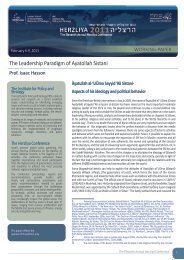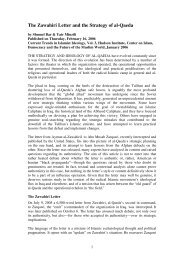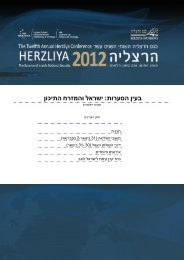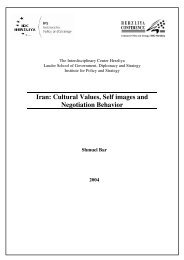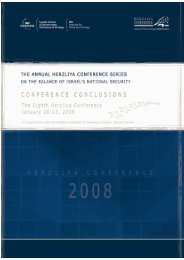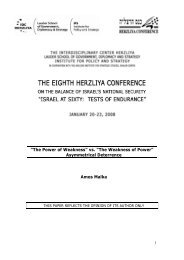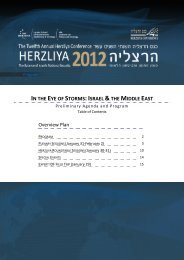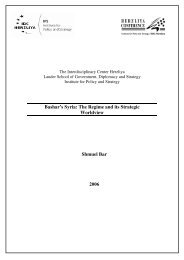Classical Islamic Paradigms of Deterrence and their Expression in ...
Classical Islamic Paradigms of Deterrence and their Expression in ...
Classical Islamic Paradigms of Deterrence and their Expression in ...
Create successful ePaper yourself
Turn your PDF publications into a flip-book with our unique Google optimized e-Paper software.
for members <strong>of</strong> the own group or nation, <strong>and</strong> an <strong>in</strong>st<strong>in</strong>ctive sense <strong>of</strong> anger <strong>and</strong> suspicion aga<strong>in</strong>st outsiders.The mixture between abstract threat <strong>and</strong> concrete fear is <strong>of</strong>ten manipulated by creat<strong>in</strong>g a collective alteredstate <strong>of</strong> consciousness with<strong>in</strong> the population that may be described as "security-phobia." A phobia ischaracterized by abstract fear (lack <strong>of</strong> security) projected on concrete matters (terrorist attacks), which <strong>in</strong>turn allows avoidance-behavior (security policies, for example deterrence) <strong>and</strong> <strong>in</strong>creases the feel<strong>in</strong>g <strong>of</strong>security among the population. However, this technique still does not <strong>of</strong>fer any solution for a work<strong>in</strong>gdefense mechanism aga<strong>in</strong>st <strong>in</strong>ner fears, <strong>and</strong> is therefore rejected by many psychiatrists <strong>in</strong> <strong>in</strong>dividualtreatment therapy. 53 Populations <strong>in</strong> general suffer from cultural biases that can be turned <strong>in</strong>to collectivestates <strong>of</strong> fear that are phobia-like. Their senses <strong>of</strong> fear are characterized, among Westerners, for example,by the perception <strong>of</strong> Muslims as backward, fanatic, irrational terrorists. Among Muslims a perception <strong>of</strong>degradation, cultural <strong>and</strong> military imperialism <strong>and</strong> Jewish-Christian conspiracy aga<strong>in</strong>st Islam prevails.Westerners are <strong>of</strong>ten seen as technocratic people without spiritual ideals. With its foreign policy, the U.S.further aggravates other deep seated <strong>in</strong>ner fears <strong>of</strong> Muslims. Muslims fear <strong>their</strong> own cultural demise,<strong>in</strong>capability to self-organize <strong>and</strong> are search<strong>in</strong>g for reasons. The U.S. presents itself as a welcome projectionsurface for the quasi-phobic fear <strong>of</strong> Muslim fundamentalists from Western cultural <strong>and</strong> military dom<strong>in</strong>ance.On the other h<strong>and</strong>, the enemy image <strong>of</strong> Islamism can be seen as a compensatory reaction to the lack <strong>of</strong>ideological adversaries by the West. Enemy pictures are always a welcome escape from self-reflection.Furthermore, self-victimization plays an important role <strong>in</strong> the dynamics <strong>of</strong> politico-religious conflicts <strong>and</strong>deterrence policies. Only heroes can protect the own victimized group; yet the archetypical "hero" needs todie for the sake <strong>of</strong> the community. The hero carries the collective victimization on his shoulders. His selfsacrificialact, propagated through mythical narratives <strong>of</strong> bravery, is also supposed to have a deterr<strong>in</strong>geffect on the enemy (evidence: epigraphic <strong>and</strong> medial deterrence by punishment). Martyrdom thenbecomes legitimate, if it preserves the own group. Thus, myths <strong>of</strong> victimization, heroism <strong>and</strong> self-sacrificeare <strong>in</strong>extricably connected to deterrence strategies <strong>and</strong> the build-up <strong>of</strong> fears <strong>and</strong> aggressions, f<strong>in</strong>ally thecohesion <strong>of</strong> groups.Common rituals, such as prayer, <strong>and</strong> talk on shared cultural values can further aggression <strong>and</strong> <strong>in</strong>-group outgroupbias, as much as they dim<strong>in</strong>ish <strong>in</strong>-group frictions. 54 Ritual group behavior strengthens collectiveidentity. Among jihadis, ceremonial rituals such as oaths <strong>of</strong> allegiance, eulogiz<strong>in</strong>g God <strong>in</strong> dialogues <strong>and</strong>s<strong>in</strong>g<strong>in</strong>g <strong>and</strong> war-dance rituals play essential roles for deterrence perceptions <strong>and</strong> collective identity.Empirical proves exist <strong>in</strong> jihadi reality, for example testimonies <strong>of</strong> drop-outs <strong>and</strong> captives, as well as <strong>in</strong> jihadipropag<strong>and</strong>a <strong>and</strong> discourse, which serve as social glue. An essential goal <strong>of</strong> propag<strong>and</strong>a is to address both<strong>in</strong>ternal <strong>and</strong> external fears <strong>of</strong> friend <strong>and</strong> foe. The enemy needs to be <strong>in</strong>timidated <strong>and</strong> the memberstrengthened <strong>in</strong> his conviction to fight out <strong>of</strong> fear from harm, but also out <strong>of</strong> excessive hubris. The closergroup members get, the more aggressive they become aga<strong>in</strong>st the outside world. 55 This behavior is bornout <strong>of</strong> prehistoric <strong>in</strong>st<strong>in</strong>ctive patterns <strong>of</strong> socialization. 56 Fear, fright <strong>and</strong> distanc<strong>in</strong>g from an enemy werelearned as survival mechanisms by early hom<strong>in</strong>ids. The best way to keep a distance from enemies is by<strong>in</strong>timidation. Show <strong>of</strong> <strong>in</strong>timidation is best created by real preparedness to fight. The altered state <strong>of</strong>consciousness, which is called "battle trance," may have been first <strong>in</strong>duced through ritualistic group53 Karl Peter Kisker, "Psychiatrie <strong>in</strong> der Gegenwart: Forschung und Praxis", B<strong>and</strong> 2, Teil 1, Hamburg, Spr<strong>in</strong>ger Verlag, 1972, p. 408.54 Eugene G. D'Aquili, "Human Ceremonial Ritual <strong>and</strong> the Modulation <strong>of</strong> Aggression," Zygon-Journal <strong>of</strong> Religion <strong>and</strong> Science 20, 1985, pp.21-30.55 See for a more detailed discussion Philipp Holtmannn, "Leadership <strong>in</strong> Cyberspace: An Organizational Network Analysis <strong>and</strong> Socio-Anthropological Study <strong>of</strong> Communicative Leadership Patterns among Onl<strong>in</strong>e-Jihadi Groups," dissertation-thesis University <strong>of</strong> Vienna,h<strong>and</strong>ed <strong>in</strong> August 2012.56 Richard Wrangham <strong>and</strong> Dale Peterson, "Demonic Males: Apes <strong>and</strong> the Orig<strong>in</strong>s <strong>of</strong> Human Violence", New York: Houghton Miffl<strong>in</strong>, 1996,pp. 194-199.17



